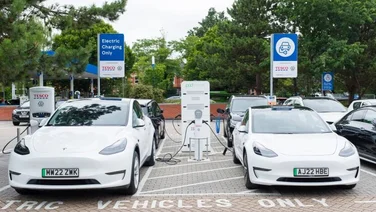- The green levy is a climate change tax, introduced by the UK government in 2001
- Green levies make up about 8% of energy bills, which is an average of £155 per year
- Scrapping the tax would reduce energy bills but lead to higher costs in the long run
Green levies are a tax measure imposed by the government on sources of pollution, which in the UK can be found on the energy bill for households. They amount to about 13% of a household’s bill and raises funds for the government to support energy-efficiency schemes in the UK.
But are a good idea or should they be scrapped?
We’ll dive deep into this, exploring everything you need to know about the climate-change tax and its future.

What is the green levy and how does it work?
As mentioned above, green levies are taxes imposed by a government on contributors to climate change, such as pollution or carbon emissions.
With this, the government wants to discourage the use of inefficient sources of energy and instead encourage the implementation of environmentally friendly alternatives. For example, fuel-inefficient vehicles have to pay a levy as part of London’s ultra-low emission zone.
The green levy colloquially describes several green levies that are part of domestic energy bills in the UK. It is used to fund social and environmental challenges, like insulation, cutting emissions, and supporting those who need it with lower energy bill costs.
Some of the specific energy-efficiency schemes that the green levy has funded include the Energy Company Obligation (ECO) and the Local Authority Flex Scheme (LA Flex).

Get free solar panel quotes
Answer a few quick questions, and our trusted installers will send you bespoke solar panel quotes – for free.
What impact does the green levy have on energy bills?
Green levies is applied to dual bills for electricity and gas, which are common in the UK. As of 2025, the green levies amount to about 13%, which for an average energy bill of £2,500 a year, amounts to a levy of roughly £228.15.
Without green levies, the price of gas and electricity for households would be around £1,526 per year.
However, it is important to know that the wholesale price of gas and electricity is the main reason for the recent hike in energy costs. This is the price that energy companies pay and then pass over to the consumers. Energy efficiency schemes funded by the levy aim at lowering these costs in the mid- to long-term.
Why was the green levy implemented?
The tax supports vulnerable households and aims at reducing energy costs for everyone in the future by implementing schemes like ECO and LA Flex.
Has the green levy been a success?
Overall, the levy has been a success so far, funding upgrades to renewable technologies, better insulation, financial support for heating, and cost savings for households.
Programmes like ECO and the Green Homes Voucher have had a major impact on lower-income people: ECO alone has delivered improved infrastructure to over 2.3 million households in the UK. This amounts to an estimated cost saving of £290 per year for vulnerable households.
Has the green levy had an impact environmentally?
According to the Insulation Assurance Authority, this has resulted in a reduction of over 26.2 million tonnes of carbon emissions and a reduction of fuel bills by a total of £6.2 billion.
The scheme has also supported the rise of renewable technology and dropped the demand for fossil fuels, for example, through the Boiler Upgrade Scheme. This has helped the UK in its aim to achieve net zero emissions by 2050.

What would happen if the UK removed the levy?
Removing green levies is something that conservative and climate change-sceptic politicians have called for in the past. Every increase in energy bills, in fact, tends to lead to calls for scrapping the green levy. However, this is not the solution.
At first, it seems like removing the green levy would slightly decrease energy bills. However, losing programmes like ECO and LA Flex would quickly lead to higher electricity prices. Houses without insulation will need more energy, for example. And the most vulnerable households would lose valuable support.
Green levies represent only a small fraction of bills. Increases are being driven by record-high wholesale prices. Without the green levy, there would be fewer policies in place to stop even higher price increases. This means that the green levy more than pays for itself.

Get £7500 towards your heat pump installation through a trusted installer
An MCS-certified heat pump installer can apply for the Boiler Upgrade Scheme on your behalf, get a quote from one now
Is the UK government planning to scrap the levy?
Maybe. Media speculation ahead of the Autumn 2025 Budget suggests that green levies might be cut as Rachel Reeves the Chancellor bids to bring down energy bills, reports which have been met with alarm by energy experts.
Do any other European countries have an equivalent?
In France, consumers pay a public electricity service contribution. This charge supports renewable energy development and energy efficiency programmes. Similarly, Spain has a green levy on electricity consumption. And Denmark uses its green levy to support wind energy projects and research and development initiatives for renewable energy.
Summary
- The Green Gas Levy (GGL), also known as the Green Fund Levy, is another green tax in operation in the UK which charges all licensed fossil fuel gas suppliers in Great Britain to pay a quarterly levy
- The tax benefits all of us by insulating homes, reducing CO2 emissions, and future-proofing energy supply. It supports vulnerable parts of the population with upgrading and insulating their homes, which can save hundreds of pounds in overall fuel costs
- There are no exemptions for paying the tax as part of the energy bill. For the GGL, there are exemptions for suppliers that can prove their total gas supply comprises at least 95% certified biomethane
- The tax has been successful so far and while some programmes can be improved, it is an important way of fulfilling our social and environmental responsibilities
- At the same time, the green tax helps to secure our future energy supply by supporting renewable energies

Get free solar panel quotes
Answer a few quick questions, and our trusted installers will send you bespoke solar panel quotes – for free.







